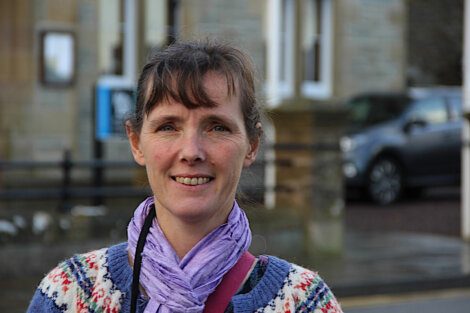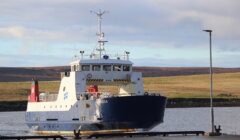Transport / Councillor makes case for tunnels in front of MSPs on parliament committee
Moraig Lyall said fixed links ‘hit the button not just financially, but economically, socially and environmentally’
CONSTRUCTING tunnels to four of Shetland’s islands could cost around £400 million, according to estimates.
The figure was mentioned by Shetland Islands Council’s environment and transport committee chair Moraig Lyall when she spoke at a Scottish Parliament committee meeting on Tuesday.
She passionately spoke up for the idea of replacing ferry links to Shetland’s busiest islands with tunnels, saying they would have economic, social and environmental benefits.
Lyall said the £400 million figure, given to a meeting of the parliament’s net zero, energy and transport committee, was a “very quick” calculation.
But she highlighted that the Scottish Government gives the council money towards running its internal ferries – nearly £18 million this financial year – and the cost of running the service, and its ageing vessels, continues to rise.
The councillor said on that basis “tunnels suddenly become a much more affordable and attractive option”.
“They hit the button not just financially, but economically, socially and environmentally,” Lyall continued. “Our small island economies are constrained by the capacity of these small ferries.”
The islands in question which are earmarked for fixed links are Yell, Unst, Whalsay and Bressay.
The council as a whole is in favour of pursuing fixed links, such as tunnels, to replace ferries in the long term, but financing them is the stumbling block.
Previously the Scottish Government, which has control over transport issues, said Shetland’s ferries were the responsibility of the council – and as a result so were their potential replacements.
But council chief executive Maggie Sandison said this week that there appeared to be a softening in this stance, particularly when it came to ferry replacements.
Lyall told the parliament committee that the aquaculture sector, which has strong links to Shetland’s North Isles, was possibly willing to contribute financially to exploring the idea of fixed links.
Become a member of Shetland News
“We have lorry loads of fish that sit on the end of the pier in Yell wondering if they’re going to get on and make it down to Lerwick in time to catch the ferry that evening, particularly in the high season where there are a lot of tourists around,” she added.
Shetland Islands Council is due to set its budget for the 2023/24 financial year soon, and it is already warning of potential cuts to services amid increased costs, rising demand and “reduced government funding”.
The parliament committee heard that the council has put in place a plan to produce a report over the next year or two that will “give an entire look at our current set-up, and the inclusion of tunnels as an option”.
Lyall said that lengthy piece of work could cost around £400,000 to £600,000.
She acknowledged the financial constraints around the council but said “we need to make movement on this now”.
This is because at the moment figures suggest the Scottish Government will give the council the same as 2022/23 – not the £23 million requested amid rising costs.
It said that ferry maintenance could be deferred if this is the case. However, the report also said the SIC could seek to pursue external funding for fixed links feasibility studies.
Lyall said fixed links have general support from the islands, while action groups have been set up in Yell and Unst.
She said there may need to be some form of “innovative financing model” to make them happen.
The councillor added that a toll, where people would pay to use a tunnel, would be likely.
She said the council has been largely “kept at arms length” in talks with Transport Scotland on the issue.
But Lyall was clear in her mind that tunnels would be likely to improve the fortunes of Shetland’s main islands.
“We already have in Shetland three islands which are connected to our mainland – Burra, Trondra, Muckle Roe,” she told the committee.
“Since the links to them, bridges, were put in, all of them have steadily increased their population. Every other island that is served by a ferry service has steadily decreased its population.
“Tunnels, fixed links, bridges – they do work in terms of retaining people within the islands.”
In a statement released on Wednesday, a spokesperson for Transport Scotland said replacing ferries with fixed links remains out of scope for the government agency.
“Last year we published the second Strategic Transport Projects Review (STPR2), setting out 45 recommendations for future transport investment over the next 20 years,” they said.
“STPR2 did not consider the replacement of local ferry services by fixed links. This was out of scope, given it is a matter for the local authorities who manage and operate these.
“However we recognise the importance of these internal services to the Northern Isles and have provided local authorities with over £136 million of investment in the last five years to support their operation.
“For this financial year more than £33 million has been made available, including over £17 million for Shetland Islands Council.”
Tuesday’s committee meeting also discussed external ferries, with a speaker from Orkney also in attendance.
Lyall repeated long-held concerns about the ‘three Cs’ when it came to the Northern Isles ferry service – capacity, cabins and cost.
She said issues like the price of travel were barriers to Shetland growing its population.
The councillor did say, though, that there were “many positives” about Serco NorthLink’s service.
“It’s a regular, reliable service – it just isn’t big enough, [and] it’s too expensive,” Lyall said.
Become a member of Shetland News
Shetland News is asking its many readers to consider paying for membership to get additional features and services: -
- Remove non-local ads;
- Bookmark posts to read later;
- Exclusive curated weekly newsletter;
- Hide membership messages;
- Comments open for discussion.
If you appreciate what we do and feel strongly about impartial local journalism, then please become a member of Shetland News by either making a single payment, or setting up a monthly, quarterly or yearly subscription.













































































